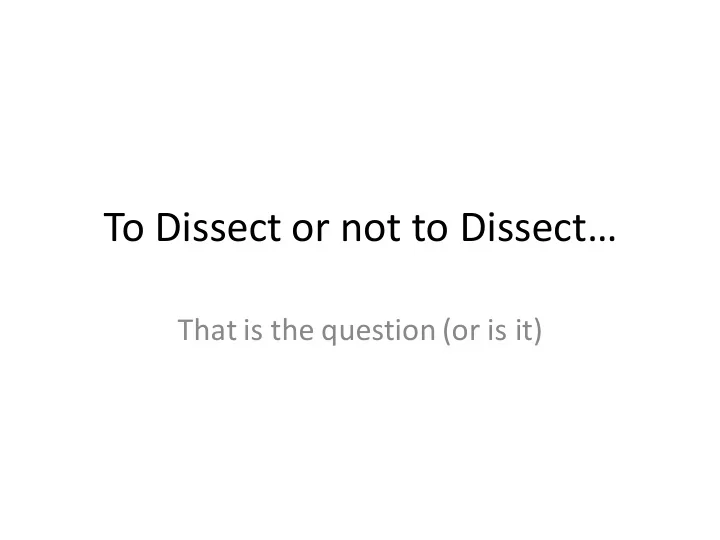

To Dissect or not to Dissect… That is the question (or is it)
Historical perspective of cadaveric dissection (+) Time honored tradition (+) Historically been the preferred mode of instruction (Patel KM et al., 2006; APTA, 2002) + observation of anomalies + 3-d perspective + respect for the human form (Aziz M et al.,2002) (-) Advances in medical technology raise concerns regarding adequacy of cadaveric dissection alone (-) Rising costs, shortage of qualified instructors, concern re formaldehyde exposure
Pros and Cons of “Modern” Modes • Prosections: ❖ + 3D realistic structures, time (students), re-usable, space required; student preferences (dissection over prosection) ❖ - tissue layers, relationships between regions; time (faculty); less "exploration" and variety for students than dissection; H &S • Models/plastination: ❖ + convenience, re-usable, H & S, can be semi-3D ❖ -3D, true representation, variation, texture • Digital media: ❖ + convenient, accessible, efficient; H & S, space, or religious concerns; "impressive"; cost? ❖ -not true 3D; variability, accuracy, realism, tissue integrity; cost? • Living Anatomy: + but probably not enough by itself
WHAT DOES THE EVIDENCE SAY?
Dissection vs Computer Assisted Instruction & Prosection • Plack MM, 2000 – Use of computer assisted instruction (CAI) and prosections compared to traditional instruction • No difference in mean practical, written or final course grades between groups
Dissection vs Digital media • Peterson DC, et al., 2016 – Traditional v traditional + supplemental 3D resources • 3d enhanced group demonstrated: – Significant improvement in overall scores (p < 0.01, 99% CI 1.8%, 5.9%) – Significant improvement in cadaver related questions but not lecture-based question
Digital Dissection v Digital Media • Lombardi SA et al., 2014 – Compared one session of instruction with plastic model, organ dissection or virtual dissection • Organ dissection and model groups performed significantly better on anatomy questions that did the virtual dissection group
Dissection vs Hybrid approach • Wilson AB et al. 2011 – Compared alternating dissection with peer teaching to more traditional dissection approach • No significant differences in course grades between groups
Summary of Comparisons • Level 1 evidence: – Meta-analysis (Wilson AB et al., 2018) • No effect on short-term outcome gains when comparing traditional dissection to other modes of instruction (prosection, digital media, models, hybrid)
Challenges with current literature • Heterogeneity of outcomes assessed • Heterogeneity of delivery methods
Gaps in the literature • What is the effect of various instructional methods and/or “best practice” on long -term information retention? • Does dissection facilitate development of ancillary skills better than other methods? – Teamwork, stress management, empathy (Bockers A et al., 2010) • What is the effect of emotion on learning through cadaveric dissection vs other methods? – Surprise and wonderment with ID of anomalies and/or pathology (Korf HW et al., 2008) – Respect for human form (McBride and Drake, 2015)
Best Education Practices Defined • “wide range of individual activities, policies, and programmatic approaches to achieve positive changes in student attitudes or academic behaviors ” David Arendale, Ph.D., EOA National Best Practices Center Manager and Associate Professor, University of Minnesota, http://www.besteducationpractices.org/what-is-a-best-practice/ • Includes: – Promising education practice (innovative technologies) – Validated education practice (frequent low stakes assessment, active learning) – Exemplary education practice (cadaveric dissection)
Examples • Chapman: horizontal and vertical integration – Semester 1: multiple modalities, including prosections; clinical reasoning/application; lab "stations" – Semester 6: (after ICE and 1 FT clinical rotation, most didactic and basic science courses); full body dissection + special project; heavy on clinical application • Drexel: horizontal and vertical integration – Year 1: full body dissection; prosected joints, images, bone boxes – Year 2: return trips to lab to review joint anatomy within orthopedic courses (UE, LE, spine)
Future Directions • Standardization of what to teach – Must know – Nice to know • Standardization of outcomes • Determining best practice within the confines of resources
References 1. Patel KM, Moxham BJ. Attitudes of professional anatomists to curricular change. Clin Anat . 2006;19(2):132- 141. doi: 10.1002/ca.20249 [doi]. 2. Aziz MA, McKenzie JC, Wilson JS, Cowie RJ, AyeniSA, Dunn BK. The human cadaver in the age of biomedical informatics. Anat Rec . 2002;269(1):20-32. doi: 10.1002/ar.10046 [pii]. 3. McBride JM, Drake RL. Longitudinal cohort study on medical student retention of anatomical knowledge in an integrated problem-based learning curriculum. Med Teach . 2016;38(12):1209-1213. doi: 10.1080/0142159X.2016.1210113 [doi]. 4. Korf HW, Wicht H, Snipes RL, et al. The dissection course - necessary and indispensable for teaching anatomy to medical students. Ann Anat . 2008;190(1):16-22. doi: 10.1016/j.aanat.2007.10.001 [doi]. 5. Wilson AB, Petty M, Williams JM, Thorp LE. An investigation of alternating group dissections in medical gross anatomy. Teach Learn Med . 2011;23(1):46-52. doi: 10.1080/10401334.2011.536892 [doi]. 6. Bockers A, Jerg-BretzkeL, Lamp C, Brinkmann A, TraueHC, Bockers TM. The gross anatomy course: An analysis of its importance. Anat Sci Educ . 2010;3(1):3-11. doi: 10.1002/ase.124 [doi]. 7. Wilson AB, Miller CH, Klein BA, et al. A meta-analysis of anatomy laboratory pedagogies. Clin Anat . 2018;31(1):122-133. doi: 10.1002/ca.22934 [doi]. 8. DeHoff ME, Clark KL, Meganathan K. Learning outcomes and student-perceived value of clay modeling and cat dissection in undergraduate human anatomy and physiology. Adv PhysiolEduc . 2011;35(1):68-75. doi: 10.1152/advan.00094.2010 [doi]. 9. Lombardi SA, Hicks RE, Thompson KV, Marbach-Ad G. Are all hands-on activities equally effective? effect of using plastic models, organ dissections, and virtual dissections on student learning and perceptions. Adv Physiol Educ . 2014;38(1):80-86. doi: 10.1152/advan.00154.2012 [doi]. 10. Peterson DC, MlynarczykGS. Analysis of traditional versus three-dimensional augmented curriculum on anatomical learning outcome measures. Anat Sci Educ . 2016;9(6):529-536. doi: 10.1002/ase.1612 [doi]. 11. Plack MM. Computer-assisted instruction versus traditional instruction in teaching human gross anatomy. Journal of Physical Therapy Education. 2000; 14(1) 38-43. Click to add text
Recommend
More recommend